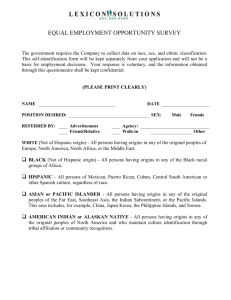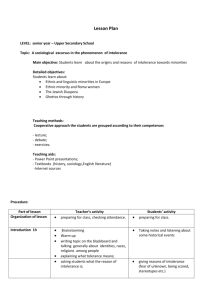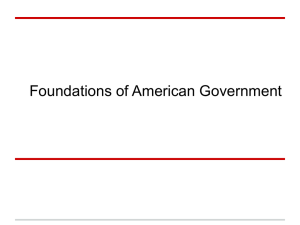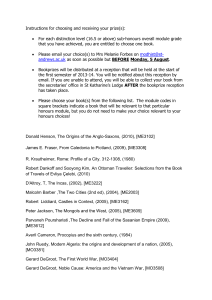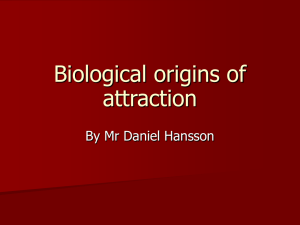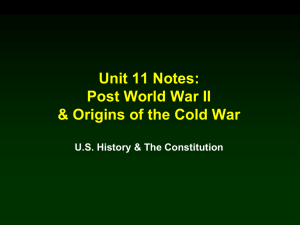To inquire into the following
advertisement
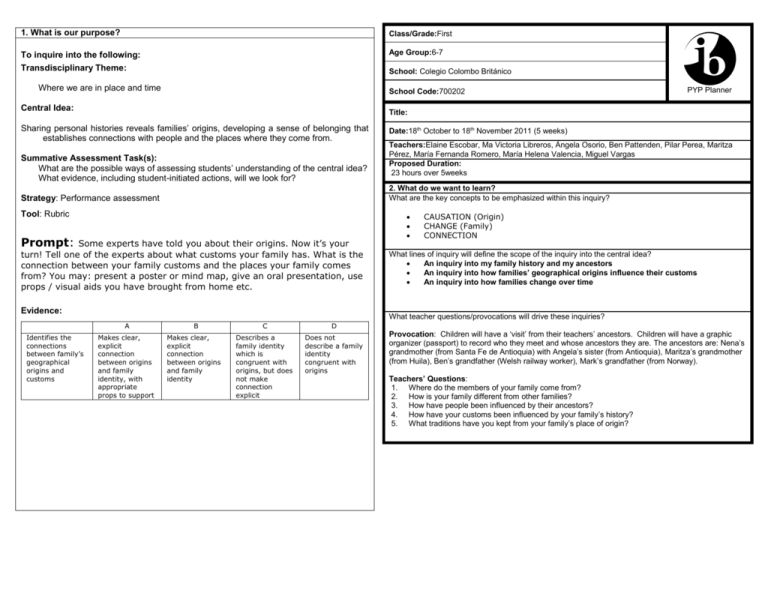
1. What is our purpose? Class/Grade:First To inquire into the following: Transdisciplinary Theme: Age Group:6-7 School: Colegio Colombo Británico Where we are in place and time School Code:700202 Central Idea: Title: Sharing personal histories reveals families’ origins, developing a sense of belonging that establishes connections with people and the places where they come from. Summative Assessment Task(s): What are the possible ways of assessing students’ understanding of the central idea? What evidence, including student-initiated actions, will we look for? Date:18th October to 18th November 2011 (5 weeks) Teachers:Elaine Escobar, Ma Victoria Libreros, Ángela Osorio, Ben Pattenden, Pilar Perea, Maritza Pérez, María Fernanda Romero, María Helena Valencia, Miguel Vargas Proposed Duration: 23 hours over 5weeks 2. What do we want to learn? What are the key concepts to be emphasized within this inquiry? Strategy: Performance assessment Tool: Rubric Prompt: Some experts have told you about their origins. Now it’s your turn! Tell one of the experts about what customs your family has. What is the connection between your family customs and the places your family comes from? You may: present a poster or mind map, give an oral presentation, use props / visual aids you have brought from home etc. Evidence: CAUSATION (Origin) CHANGE (Family) CONNECTION What lines of inquiry will define the scope of the inquiry into the central idea? An inquiry into my family history and my ancestors An inquiry into how families’ geographical origins influence their customs An inquiry into how families change over time What teacher questions/provocations will drive these inquiries? A Identifies the connections between family’s geographical origins and customs PYP Planner Makes clear, explicit connection between origins and family identity, with appropriate props to support B Makes clear, explicit connection between origins and family identity C D Describes a family identity which is congruent with origins, but does not make connection explicit Does not describe a family identity congruent with origins Provocation: Children will have a ‘visit’ from their teachers’ ancestors. Children will have a graphic organizer (passport) to record who they meet and whose ancestors they are. The ancestors are: Nena’s grandmother (from Santa Fe de Antioquia) with Angela’s sister (from Antioquia), Maritza’s grandmother (from Huila), Ben’s grandfather (Welsh railway worker), Mark’s grandfather (from Norway). Teachers’ Questions: 1. Where do the members of your family come from? 2. How is your family different from other families? 3. How have people been influenced by their ancestors? 4. How have your customs been influenced by your family’s history? 5. What traditions have you kept from your family’s place of origin? 3. How might we know what we have learned? This column should be used in conjunction with “How best might we learn?” 4. How best might we learn? What are the possible ways of assessing students’ prior knowledge and skills? What evidence will we look for? An inquiry into my family history and my ancestors, An inquiry into how families’ geographical origins influence their customs The children draw their family. Who constitutes their family is down to them. They write by each person where they come from, if they know. They respond in writing to the question: “What customs does your family have? / What special things do they do?” Strategy:Open ended task Tool:Anecdotal records What are the learning experiences suggested by the teacher and/or students to encourage the students to engage with the inquiries and address the driving questions? What are the possible ways of assessing student learning in the context of the lines of inquiry? What evidence will we look for? Interviews: Expert The children interview a lady who makes ‘macetas’ to inquire into how this custom is particular to the local area and why it has been maintained for so long. The children visit Museo Piedechinche to inquire, with the help of a guide, into what families were like in the past and what customs have been continued or not continued in this local area. The children visit Museo Arqueológico La Merced to inquire into what customs local people have inherited from their ancestors. The children interview different children’s grandparents about their geographical origins and how these influence their customs, and how their families have changed over time. An inquiry into my family history and my ancestors An inquiry into how families’ geographical origins influence their customs The children identify the nature of their family history and their customs by completing a chart with 3 columns: Family member/Ancestor, Place of origin, and Customs. Strategy: Selected response Tool: Continuum Evidence: The children identify special characteristics of the family, including its origins and customs. An inquiry into how families change over time Families used to be bigger Families used to live close together Families used to eat together Families used to spend more time together The children create a T-chart to compare what family life was like in the past and what it is like now. Strategy: Selected response Tool: Checklist Evidence: Children mention different ways in which their own, or other, families change over time. 5. What resources need to be gathered? What people, places, audio-visual materials, related literature, music, art, computer software, etc. will be available? How will the classroom environment, local environment, and/or the community be used to facilitate the inquiry? People: Members of Alianza Colombo Japonesa including parent Patricia Castro, Eleanor Cosh (Scotland), Mark Lundy (USA), Gabriela (Mexico), teachers, all parents and other family members. Places: Museo del Oro, Museo arqueológico la Merced, Audio-visual materials: Powerpoint presentation on teachers’ origins, DVD, Google Earth, web-based maps Bibliography: see annex Music: Scottish ceilidh music Computer software:Powerpoint Media: Printed, audiovisual, internet The children use Google Earth to inquire into the location of and distances between different cities which their ancestors come from. The children use a simple ICT presentation to inquire into typical features of different regions / cities of Colombia. Surveys: Regular people The children ask 10 teachers/employees where they were born, collect and organize this data into bar graphs. The children ask 10 teachers/employees what customs are local to Cali. Observation / Experience: Active, hands-on Some of the children’s grandparents visit them to teach an activity which is a custom of their family The children make a ‘human map’ to give a basic idea of the perspective of distances between different cities in Colombia and in different countries with which the children have links. What opportunities will occur for transdisciplinary skills development and for the development of the attributes of the learner profile? Transdisciplinary Skills: Communication:Speaking(L2 Giving oral reports to groups) Self-management: Spatial awareness(Maths: Understanding of positions in maps) Maths activities working on understanding of prepositions, location of objects within the classroom (Maths) Use of Google Earth to gain some comprehension of relative distances. Social: Respecting others(PSE: recognize the difference of others’ personal histories and origins) Demonstrating respect for traditions of those visiting experts, and classmates, which are different to the children’s own Thinking:Analysis (Social Studies: Make connections between personal histories and traditions) Research: Collecting data(Social Studies: gathering information from interviews and visit to different places) Learner Profile Communicators:listening to experts and asking appropriate questions Inquirers:Inquiring into the origins and cultures of both their own families and other people. Open-minded:learning about differences in the traditions different people have 6. To what extent did we achieve our purpose?Assess the outcome of the inquiry by providing evidence of students’ understanding of the central idea. The reflections of all teachers involved in the planning and teaching of the inquiry should be included. The children in BF noticed that a family in the book ‘My Grandmother’s Hands’ appeared to be Chinese but living in the USA. They noticed how this affected the food that they eat, and the way they look. They were interested to know if the girl would speak English and how she would have learned it, and made connections with their own experiences. During the summative assessment of this, the children were able to mention some of the traditions practiced in their families as a product of their geographical location and family origins. Through the inquiry, children also realized that in spite of having been born in one place, their identity was shaped by aspects of other regions and that’s why they eat typical foods or dress typical clothes from a different city or country to their birthplace. The children were enthusiastic assuming the different tasks that were proposed and getting to know their families´origins. Many of them brought objects and food from home to enrich their Performance Assessment. (RF) How you could improve on the assessment task(s) so that you would have a more accurate picture of each student’s understanding of the central idea. . To have real experts as an audience, so that children can find a meaning in their performance. - Many children identified their families’ origins, and some of their current characteristics, but did not make a clear link between their families’ origins and their present day. We should ask visiting experts to be more explicit about the way in which their lives are influenced by their origins, and also be more explicit in the way we ask the children to do this. - Do more concrete things regarding time related activities, like a time-line to link the abstract meaning of origin with the present, the past and the future. What was the evidence that connections were made between the central idea and the transdisciplinary theme? . Children had the possibility to explore maps and in the Internet the geographical aspects of their places of origin and the experts’ presentations made them aware of how the geographical features of places influence the dressing, food and traditions. - There were clear connections with regard to personal histories, as the children inquired into their own, their families´ and other people’s personal histories, particularly where they came from. - Many of them were proud to talk about their origins and were able to discuss them among them. 7. To what extent did we include the elements of the PYP? What were the learning experiences that enabled students to: Develop an understanding of the concepts identified in “What do we want to learn?” CAUSATION (Identity):The children will interview family members of their choice to find out their place of origin as well as the physical and cultural characteristics of this place of origin, visiting experts talking about the characteristics of their places of origin, inquiring into the characteristics of families’ places of origin, researching in books to find how geographical origins affect families’ characterstics, field trip to Museo del Oro and Museo La Merced, comparing experts’ characteristics to those of Colombia. FUNCTION (Family):The children will interview family members of their choice to find out their place of origin as well as the physical and cultural characteristics of this place of origin, the children will present the findings of their interviews of family members, to share their origins with their classmates, open-ended inquiry into the origins of different family members. FUNCTION (System):Inquiry into the way in which different family members’ origins have a knock-on effect on the characteristics of the family. REFLECTION (Origin):The children will inquire into the local history of arts and crafts and indigenous culture through visiting 2 local museums (Museo del Oro y MuseoArqueologico La Merced) where they will be observing, collecting data and listening to experts., inquiring into the places of origin of children’s own families, visiting experts describing their places of origin. Demonstrate the learning and application of particular transdisciplinaryskills?Communication: Listening:- The children will inquire through listening and asking questions to the following experts: parents from First Grade who are from different countries: Mark (USA), Gabriela (Mexico), Eleanor (Scotland). - The children will create origami bats during a workshop given by members of the Alianza Colombo Japonesa. - The children will inquire into the local history of arts and crafts and indigenous culture through visiting 2 local museums (Museo del Oro y MuseoArqueologico La Merced) where they will be observing, collecting data and listening to experts. - Classmates’ sharing of homework interview findings, listening to others’ performance assessments, using listening skills to identify the ‘characters’ of the provocation activity. Viewing:The children will use Google Earth and other maps to identify places that are familiar to them and discuss the features of a map. - The children will access and discuss a Powerpointpresentation on the origins of their teachers. - Viewing the visual aids that classmates used during their performance assessment, interpreting pictures in books about different cultures, viewing the costumes used in the provocation to help identify the ‘characters’, viewing Powerpoint presentations, photos and visual aids brought by visiting experts. Self Management: Spatial Awareness: -The children will use Google Earth and other maps to identify places that are familiar to them and discuss the features of a map. Social: Respecting Others: The children will discuss ways in which people are different and in what ways this is significant or not. (Afectividad) Listening sensitively and open-mindedly to the visiting experts as well as classmates with different origins, showing interest in what people of different origins have to say. Thinking: Acquisition of knowledge: The children will use non-fiction books to inquire into different cultures around the The children will inquire into the local history of arts and crafts and indigenous culture through visiting 2 local museums (Museo del Oro y MuseoArqueologico La Merced) where they will be observing, collecting data and listening to experts. The children will inquire through listening and asking questions to the following experts: parents from First Grade who are from different countries: Mark (USA), Gabriela (Mexico), Eleanor (Scotland). - The children will interview family members of their choice to find out their place of origin as well as the physical and cultural characteristics of this place of origin. Develop particular attributes of the learner profile and/or attitudes? Profile Communicators: The children will present the findings of their interviews of family members, to share their origins with their classmates. - The children will interview family members of their choice to find out their place of origin as well as the physical and cultural characteristics of this place of origin. - The children will discuss ways in which people are different and in what ways this is significant or not. (Afectividad - Presenting performance assessment with various means (speaking, visual aids, posters), speaking and writing about their research and homework findings Inquirers: - The children will use non-fiction books to inquire into different cultures around the world. - The children will inquire through listening and asking questions to the following experts: parents from First Grade who are from different countries: Mark (USA), Gabriela (Mexico), Eleanor (Scotland). - The children will interview family members of their choice to find out their place of origin as well as the physical and cultural characteristics of this place of origin. Open minded: - The children will discuss ways in which people are different and in what ways this is significant or not. (Afectividad) - The children will inquire through listening and asking questions to the following experts: parents from First Grade who are from different countries: Mark (USA), Gabriela (Mexico), Eleanor (Scotland). - Being exposed to a wide variety of geographical and cultural backgrounds, both from local and global perspectives. Attitudes Respect: - The children will discuss ways in which people are different and in what ways this is significant or not. (Afectividad) - The children will inquire through listening and asking questions to the following experts: parents from First Grade who are from different countries: Mark (USA), Gabriela (Mexico), Eleanor (Scotland). - Listening to the visiting experts talk about their origins, demonstrating appropriate behavior and attitudes during the field trip to the museums, and when listening to classmates´ performance assessments. Curiosity: - The children will inquire into the local history of arts and crafts and indigenous culture through visiting 2 local museums (Museo del Oro y MuseoArqueologico La Merced) where they will be observing, collecting data and listening to experts. - Wanting to discover more about classmates with different origins and about children’s own families. 8. What student-initiated inquiries arose from the learning? Record a range of student-initiated inquiries and student questions and highlight any that were incorporated into the teaching and learning. Some of the children showed interest for learning about the regions their parents told them they were related to after making the interview. The children of Blue First wanted to know about the origins of a ‘new’ girl in the class, Gabriela from Portugal. Her parents were invited to come and speak to the children about Portugal. Her father came and gave a presentation, including bringing a typical souvenir and chocolate for each child. Effective teacher questions/provocations: The provocation activity engaged the children and remained meaningful for them for some time. What student–initiated actions arose from the learning? MA was enthusiastic to know more about his family origins and asked his mother to come to school to talk about them to his classmates. JEL constantly asked at home about why the family do certain things, particularly in relation to the activities his father does with his grandfather. AN has been investigating further in the internet and books. MR asked about her grandparents’ origins and surnames. She asked about our geographical location – climate etc. Daniel Berón tuvo la iniciativa de indagar sobre los orígenes de su familia y diseñó un ¨mind-map¨ para explicar sus ancestros, sus lugares de origen y sus preferencias 9. Teacher notes . We should find time to plan more activities that help the children to have a better understanding of the central idea, so that they have more tools to prepare a more accurate summative assessment. It was very positive to have experts (people from other countries) and it would also be meaningful to try to have them during the summative assessments. There were more families with ‘exotic’ origins than we anticipated. If we repeat this unit, we could send out a survey in advance of the unit to find out about families’ origins, in order to better plan our expert visits. The field trip to the MuseoArqueologico La Merced was very informative, with excellent guides who connected well with the children. The experience at the Museodel Oro was rather poor, but the children enjoyed it. The visits from parent ‘experts’ were particularly engaging, meaningful and enduring for the children. They remembered many facts about each expert and were enthused to know more about each place of origin. Para el 90% de los niños es la primera vez que tienen contacto real con sus ancestros, razón por la cual estuvieron muy interesados durante la salida, tomando abundantes notas, que luego los ayudó a realmente entender y dar cuenta del significado de la palabra origen. (RF)
